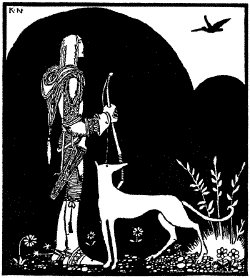I tend to use the original Index to Fairy Tales, Myths and Legends by Mary Huse Eastman, published in 1915, to guarantee Public Domain stores. I plowed through the stories for Mother's Day and others with Mother in the title. Maybe it was the mood I was in, but everything just seemed too "quaint" and I wasn't happy with telling them in the 21st century. In telling Public Domain stories it's sometimes necessary for the storyteller to modernize the language. "Thees" and other quaint word choice isn't needed to tell the story and can keep a present day audience from hearing what is meant. These stories just struck me as having an antiquated view of motherhood or children.
Quite by accident I discovered today's story and believe it will always fit the way mothers view their children. This translation
originally appeared in Sir G. W. Dasent’s Popular Tales
from the Norse, but is the Kay Nielsen illustrated version of the Asjornsen and Moe tales titled East of the Sun and West of the Moon; Old Tales from the North. That's a Project Gutenberg link, but Nielsen's work has had many reprints and I strongly recommend seeing it in book form as both the full-color and black and white illustrations really shine in print.
ONE’S OWN CHILDREN ARE ALWAYS PRETTIEST
 sportsman went out once into a wood to
shoot, and he met a Snipe.
sportsman went out once into a wood to
shoot, and he met a Snipe.
“Dear friend,” said the Snipe, “don’t shoot my children!”
“How shall I know your children?” asked the Sportsman. “What are they like?”
“Oh!” said the Snipe, “mine are the prettiest children in all the wood.”
“Very well,” said the Sportsman, “I’ll not shoot them; don’t be afraid.”
But for all that, when he came back, there he had a whole 204 string of young snipes in his hand which he had shot.
“Oh, oh!” said the Snipe, “why did you shoot my children after all?”
“What! these your children!” said the Sportsman; “why, I shot the ugliest I could find, that I did!”
“Woe is me!” said the Snipe; “don’t you know that each one thinks his own children the prettiest in the world?”
***
 |
| Snipe in Water, by Ohara Koson. Japan, 1900-1930 |
LoiS again:
I've long heard about Snipe Hunts and presumed they were hunting for something fictitious. Not so. . . well not entirely. The Wikipedia article on the Snipe mainly incorporates the old Public Domain article found in Encyclopædia Britannica (11th ed.). I wanted an update on the bird and find it as the Common snipe, which is not a North American bird. This is why a "Snipe hunt" -- at least in North America -- is considered a prank or practical joke. There are however North American birds, known as Wilson's snipe, which had been considered a subspecies until 2003 when it was changed to its own species.
Along the way on my own literary Snipe Hunt I learned the term "sniper" came from the bird because of its ability to hunt and also camouflage.
All of that may be far more than you ever cared to know. Mr. Nielsen frequently marks the end of stories with an illustration that seems appropriate to this little known tale which ends the book. (Note the short bird bills, so they are not snipes, but they hide well.)
***********************
This is part of a series of postings of stories under the category, "Keeping the Public in Public Domain." The idea behind Public Domain was to preserve our cultural heritage after the authors and their immediate heirs were compensated. I feel strongly current copyright law delays this intent on works of the 20th century. My own library of folklore includes so many books within the Public Domain I decided to share stories from them. I hope you enjoy discovering new stories.
At the same time, my own involvement in storytelling regularly creates projects requiring research as part of my sharing stories with an audience. Whenever that research needs to be shown here, the publishing of Public Domain stories will not occur that week. This is a return to my regular posting of a research project here. (Don't worry, this isn't dry research, my research is always geared towards future storytelling to an audience.) Response has convinced me that "Keeping the Public in Public Domain" should continue along with my other postings as often as I can manage it.
Other Public Domain story resources I recommend-
There are many online resources for Public Domain stories, maybe none for folklore is as ambitious as fellow storyteller, Yoel Perez's database, Yashpeh, the International Folktales Collection. I have long recommended it and continue to do so. He has loaded Stith Thompson's Motif Index into his server as a database so you can search the whole 6 volumes for whatever word or expression you like by pressing one key. http://folkmasa.org/motiv/motif.htm
You may have noticed I'm no longer certain Dr. Perez has the largest database, although his offering the Motif Index certainly qualifies for those of us seeking specific types of stories. There's another site, FairyTalez claiming to be the largest, with "over 2000 fairy tales, folktales, and fables" and they are "fully optimized for phones, tablets, and PCs", free and presented without ads.
Between those two sites, there is much for story-lovers, but as they say in infomercials, "Wait, there's more!"



No comments:
Post a Comment